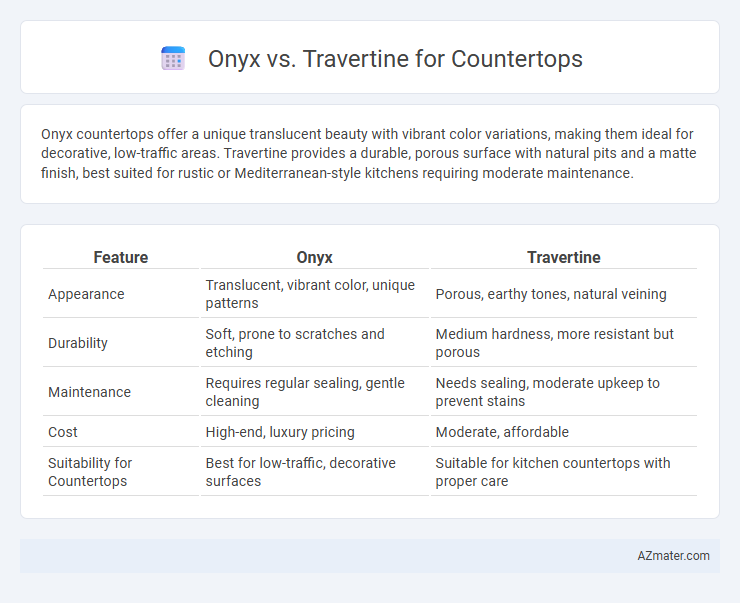Onyx countertops offer a unique translucent beauty with vibrant color variations, making them ideal for decorative, low-traffic areas. Travertine provides a durable, porous surface with natural pits and a matte finish, best suited for rustic or Mediterranean-style kitchens requiring moderate maintenance.
Table of Comparison
| Feature | Onyx | Travertine |
|---|---|---|
| Appearance | Translucent, vibrant color, unique patterns | Porous, earthy tones, natural veining |
| Durability | Soft, prone to scratches and etching | Medium hardness, more resistant but porous |
| Maintenance | Requires regular sealing, gentle cleaning | Needs sealing, moderate upkeep to prevent stains |
| Cost | High-end, luxury pricing | Moderate, affordable |
| Suitability for Countertops | Best for low-traffic, decorative surfaces | Suitable for kitchen countertops with proper care |
Introduction to Onyx and Travertine Countertops
Onyx countertops offer a translucent beauty with natural bands of vibrant colors, creating a luxurious and unique aesthetic that enhances any interior space. Travertine countertops are known for their warm, earthy tones and porous texture, providing a classic and rustic appeal with natural pitting that can be filled for a smooth finish. Both materials require proper sealing and maintenance to preserve their beauty and durability in kitchen and bathroom applications.
Key Differences Between Onyx and Travertine
Onyx countertops are known for their translucent beauty and rich color variations, offering a luxurious and unique aesthetic compared to the more matte and earthy tones of travertine. Travertine is a porous, sedimentary limestone requiring sealing to prevent stains and damage, whereas onyx is softer but more sensitive to acids and scratches, demanding careful maintenance. While travertine provides a more rustic and durable surface ideal for high-traffic areas, onyx is prized for decorative countertops where visual impact outweighs everyday wear.
Appearance and Aesthetic Appeal
Onyx countertops boast a translucent appearance with rich, vibrant veining and a glossy finish that creates a luxurious and dramatic focal point. Travertine features a natural, earthy texture with matte or honed surfaces, characterized by porous holes and neutral tones that evoke timeless elegance and rustic charm. The choice between Onyx and Travertine depends on whether a bold, luminous centerpiece or a subtle, organic aesthetic best suits the space.
Durability and Longevity
Onyx countertops offer a unique, translucent beauty but are significantly less durable and more prone to scratches and etching compared to travertine. Travertine is a form of limestone that provides greater hardness and resistance to wear, making it more suitable for high-traffic kitchen environments. Due to its porous nature, travertine requires regular sealing to maintain its longevity, whereas onyx demands extra care to prevent damage and maintain its delicate surface over time.
Maintenance and Care Requirements
Onyx countertops require delicate maintenance due to their porous and soft nature, needing regular sealing and gentle cleaning with pH-neutral products to prevent etching and staining. Travertine, although also porous, is more durable and demands consistent sealing to avoid water absorption and surface damage, with routine cleaning using mild detergents recommended. Both materials benefit from immediate spill cleanup and avoiding abrasive tools to preserve their polished surfaces and extend their lifespan.
Cost Comparison: Onyx vs Travertine
Onyx countertops typically range from $60 to $150 per square foot, making them significantly more expensive than travertine, which usually costs between $20 and $50 per square foot. The high cost of onyx is attributed to its unique translucency and limited availability, while travertine remains a budget-friendly option with durable natural stone appeal. Maintenance expenses also differ, with onyx requiring more care and sealing to preserve its delicate surface compared to the relatively low upkeep for travertine.
Suitability for Different Kitchen Styles
Onyx countertops offer a luxurious and translucent appearance that complements modern and high-end kitchen designs, enhancing spaces with dramatic lighting effects and bold color variations. Travertine, with its natural, earthy tones and textured surface, suits rustic, Mediterranean, and traditional kitchens, providing a warm and timeless aesthetic. Both materials require proper sealing and maintenance, but onyx is more delicate, making travertine a more practical choice for high-traffic kitchen environments.
Pros and Cons of Onyx Countertops
Onyx countertops offer a stunning, translucent look that adds elegance and luxury to any kitchen or bathroom, making them a unique design choice compared to travertine. Their pros include striking natural patterns and the ability to be backlit for dramatic visual effects; however, onyx is softer and more prone to scratching, etching, and staining than travertine. This delicate nature requires regular sealing and careful maintenance, limiting its practicality in high-traffic or heavy-use countertop areas.
Pros and Cons of Travertine Countertops
Travertine countertops offer a natural, porous stone surface with unique veining, lending a warm and rustic aesthetic to kitchens or bathrooms. Pros include heat resistance and a softer, more workable material ideal for custom designs, but cons involve susceptibility to scratches, staining, and the necessity for regular sealing to maintain durability. Compared to Onyx, travertine is more affordable and less prone to cracking but requires more maintenance and is less visually dramatic.
Choosing the Right Stone for Your Countertop
Onyx countertops offer a translucent, luxurious appearance with unique veining patterns but require careful maintenance due to their softness and susceptibility to scratches and etching. Travertine provides a more durable, earthy option characterized by its porous surface and natural pits, which may need sealing to prevent staining and damage. Selecting between onyx and travertine depends on the desired aesthetic, durability requirements, and willingness to perform regular upkeep to preserve the countertop's beauty.

Infographic: Onyx vs Travertine for Countertop
 azmater.com
azmater.com